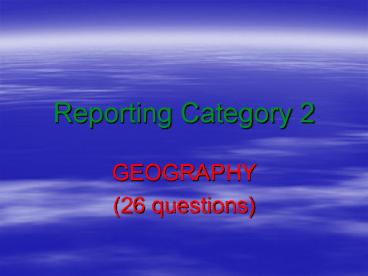Reporting Category 2 PowerPoint PPT Presentation
1 / 10
Title: Reporting Category 2
1
Reporting Category 2
- GEOGRAPHY
- (26 questions)
2
(3) GEOGRAPHY- The student understands how
physical processes shape patterns in the physical
environment.
- Explain weather conditions and climate in
relation to annual changes in Earth-Sun
relationships - Describe the physical processes that affect the
environments of regions, including weather,
tectonic forces, erosion, and soil-building
processes - Examine the physical processes that affect the
lithosphere, atmosphere, hydrosphere, and
biosphere.
3
(No Transcript)
4
RAIN SHADOW EFFECT
5
(4) GEOGRAPHY- The student understands the
patterns and characteristics of major landforms,
climates, and ecosystems of Earth and the
interrelated processes that produce them.
- Explain how elevation, latitude, wind systems,
ocean currents, position on a continent, and
mountain barriers influence temperature,
precipitation, and distribution of climate
regions - Describe different landforms and the physical
processes that cause their development - Explain the influence of climate on the
distribution of biomes in different regions.
6
(5) GEOGRAPHY- The student understands how
political, economic, and social processes shape
cultural patterns and characteristics in various
places and regions.
- Analyze how the character of a place is related
to its political, economic, social, and cultural
elements - Interpret political, economic, social, and
demographic indicators (gross domestic product
per capita, life expectancy, literacy, and infant
mortality) to determine the level of development
and standard of living in nations using the terms
Human Development Index, less developed, newly
industrialized, and more developed.
7
(6) GEOGRAPHY- The student understands the types,
patterns, and processes of settlement.
- Locate and describe human and physical features
that influence the size and distribution of
settlements - Explain the processes that have caused changes in
settlement patterns, including urbanization,
transportation, access to and availability of
resources, and economic activities.
8
(7) GEOGRAPHY- The student understands the
growth, distribution, movement, and
characteristics of world population.
- Construct and analyze population pyramids and use
other data, graphics, and maps to describe the
population characteristics of different societies
and to predict future population trends - Explain how political, economic, social, and
environmental push and pull factors and physical
geography affect the routes and flows of human
migration - Describe trends in world population growth and
distribution - Examine benefits and challenges of globalization,
including connectivity, standard of living,
pandemics, and loss of local culture
9
(8) GEOGRAPHY- The student understands how
people, places, and environments are connected
and interdependent.
- Compare ways that humans depend on, adapt to, and
modify the physical environment, including the
influences of culture and technology - Describe the interaction between humans and the
physical environment and analyze the consequences
of extreme weather and other natural disasters
such as El Nino, floods, tsunamis, and volcanoes - Evaluate the economic and political relationships
between settlements and the environment,
including sustainable development and
renewable/non-renewable resources.
10
(9) GEOGRAPHY- The student understands the
concept of region as an area of Earths surface
with related geographic characteristics.
- Identify physical and/or human factors such as
climate, vegetation, language, trade networks,
political units, river systems, and religion that
constitute a region - Describe different types of regions, including
formal, functional, and perceptual regions.

